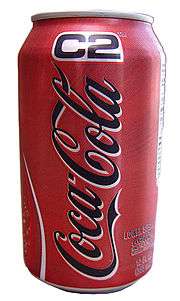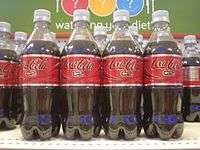Coca-Cola C2
 | |
| Type | Diet soda |
|---|---|
| Manufacturer | The Coca-Cola Company |
| Country of origin | Japan |
| Introduced | 2004 |
| Discontinued | 2007 |
| Related products | Coca-Cola Life, Pepsi ONE, Diet Coke, Coca-Cola Zero |
Coca-Cola C2 (also referred to as Coke C2, C2 Cola, or simply C2) was a cola-flavored beverage introduced by The Coca-Cola Company first in Japan, then later on June 7, 2004 in the United States (and shortly thereafter, Canada), in response to the low-carbohydrate diet trend. This Coke product was marketed as having half the carbohydrates, sugars and calories compared to standard Coca-Cola. It contains aspartame, acesulfame potassium, and sucralose in addition to the high fructose corn syrup typically found in cola beverages distributed in America. Aside from the high fructose corn syrup, one 12-ounce can of Coca Cola C2 contains 19 mg of aspartame, 4 mg of sucralose and 19 mg of acesulfame potassium. The packaging design differs from other Coke products in that the logos are printed in black. For marketing on radio and television, and movie theaters the Queen song "I Want to Break Free" was used. When it was first introduced, though, The Rolling Stones song "You Can't Always Get What You Want" was used.
American sales did not live up to early expectations mainly due to customer disinterest in a mid-calorie soda, and partly due to the success of Coca-Cola Zero, a zero-calorie version of Coca-Cola; however, Coca Cola said the brand would remain in its lineup, even while Pepsi discontinued its equivalent product, Pepsi Edge, in late 2005, just one year after its introduction. Many store shelves completely replaced the product with Coca-Cola Zero due to display, shelving and storage limitations, and with the introduction of Coca-Cola Cherry Zero, the product disappeared from all store shelves where it had previously remained, and in 2013, it was replaced by Coca-Cola Life, which was marketed for using Stevia as opposed to artificial sweeteners.
